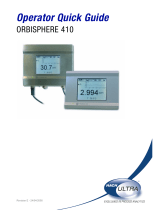
1
CONTENTS
Section Page
1 INTRODUCTION ..............................................................2
1.1 System Description ................................................. 2
1.2 PID Control ............................................................. 2
1.3 AX400 Series Analyzer Options ............................... 2
2 OPERATION.....................................................................3
2.1 Powering Up the Analyzer .......................................3
2.2 Displays and Controls.............................................. 3
2.2.1 Membrane Key Functions ............................ 3
2.3 Operating Page ....................................................... 6
2.3.1 Single Input Dissolved Oxygen ..................... 6
2.3.2 Dual Input Dissolved Oxygen ....................... 7
2.3.3 Wash Function ............................................. 8
3 OPERATOR VIEWS ......................................................... 9
3.1 View Set Points ....................................................... 9
3.2 View Outputs ........................................................ 10
3.3 View Hardware ...................................................... 10
3.4 View Software .......................................................11
3.5 View Logbook .......................................................11
3.6 View Clock ............................................................14
4 SETUP............................................................................15
4.1 Sensor Calibration .................................................15
5 PROGRAMMING ...........................................................20
5.1 Security Code ....................................................... 20
5.2 Configure Display ..................................................21
5.3 Configure Sensors................................................. 22
5.4 Configure Alarms................................................... 23
5.4.1 Wash Cycle Configuration
(applicable only to Alarm 3) ........................ 26
5.5 Configure Outputs .................................................28
5.6 Configure Clock .................................................... 30
5.7 Configure Control .................................................. 31
5.7.1 Configure Single PID Controller ..................32
5.7.2 Configure Power Failure Recovery Mode .... 35
5.8 Configure Security ................................................. 36
5.9 Configure Logbook ............................................... 36
5.10 Test Outputs and Maintenance .............................. 37
Section Page
6 INSTALLATION .............................................................. 39
6.1 Siting Requirements .............................................. 39
6.2 Mounting ............................................................... 40
6.2.1 Wall-/Pipe-mount Analyzers ....................... 40
6.2.2 Panel-mount Analyzers .............................. 41
6.3 Electrical Connections ........................................... 42
6.3.1 Relay Contact Protection
and Interference Suppression..................... 43
6.3.2 Cable Entry Knockouts,
Wall-/Pipe-mount Analyzer ......................... 44
6.4 Wall-/Pipe-mount Analyzer Connections................ 45
6.4.1 Access to Terminals ...................................45
6.4.2 Connections .............................................. 46
6.5 Panel-mount Analyzer Connections ....................... 47
6.5.1 Access to Terminals ...................................47
6.5.2 Connections .............................................. 48
7 CALIBRATION ...............................................................49
7.1 Equipment Required..............................................49
7.2 Preparation ........................................................... 49
7.3 Factory Settings ....................................................50
8 SIMPLE FAULT FINDING ..............................................55
8.1 Error Messages ..................................................... 55
8.2 No Response to DO Changes ...............................55
8.3 Checking the Temperature Input............................ 55
SPECIFICATION ..................................................................56
APPENDIX A ....................................................................... 59
A1 Oxygen Solubility in Pure Water ............................. 59
A2 Correction for Salinity ............................................ 59
A3 DO Calibration.......................................................60
A3.1 Zero Calibration ......................................... 60
A3.2 Span Calibration ........................................ 60
APPENDIX B .......................................................................61
B1 Single PID Controller ............................................. 61
B1.1 Reverse Acting Single PID Control ............. 61
B1.2 Direct Acting Single PID Control ................. 62
B2 Ouput Assignment ................................................ 62
B3 Setting Up Three Term (PID) Control Parameters ... 63
B4 Manual Tuning ....................................................... 63





















